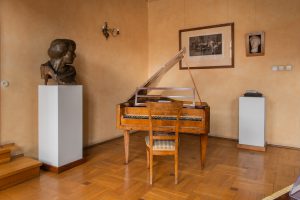Collections and Exhibition
The layout and arrangement of the new exhibition of the Museum of Musical Instruments arose from the idea of presenting musical instruments through the context of the era, ensemble, place and tradition. By visiting the Museum’s exhibition, we embark on a journey through centuries, places, phenomena and cultures.
Each of the 16 galleries directs the viewer to some area or phenomenon which is its main theme. Alongside the main theme, additional contexts and complements often appear in the given gallery. The first two floors lead the visitor through selected topics from the history of European music. The ground floor exhibition covers the period from late Middle Ages to the end of the 18th century. Selected topics from the history of general European, Polish, and locally Poznań music present the world of emerging secular instrumental music and the dominating in the Baroque period space of sacred vocal-instrumental music. The first floor of the exhibition leads the viewer through the passing in the 18th century time of court music, following in its further part to the concert halls, famous virtuosos, chamber, and salon music, up to the avant-garde music of the 20th century. The second floor, on the other hand, acquaints with the musical traditions of different cultures of the world. It discovers the wealth of forms of instruments and their functions in a given culture. It presents the extraordinary diversity of musical playing – from the simplest pre-Columbian rattles and whistles to the very complex sound and structurally Indian music.
The exhibition of the Musical Instruments Museum has been divided into 16 galleries:
On the ground floor:
1. Late Medieval Music – Alta e Bassa Musica
2. Renaissance Music Time – Era of Consorts
3. Baroque Era – Polychoral Music – Cori Spezzati
4. Sacred Music of the 18th Century – Jasna Góra Capella Claromontana
5. Sacred and Secular Music of the 18th Century – Collegium Musicorum Posnaniensis
On the first floor:
6. French court music of the 18th century
7. Music of the second half of the 18th century
8. Symphonic music of the 19th century
9. Chamber Music of the 19th century
10. Avant-garde of the 20th century
11. Piano music of the 19th century
On the second floor:
12. Instruments from the Black Sea region
13. Polish folk instruments
14. Music of the Orient – instruments from India, Iran, Mongolia and Kazakhstan
15. Music of the Orient – instruments from China, Vietnam and Myanmar, South Korea and Japan
16. Instruments from South America and Africa
The Musical Instruments Museum currently collects 2,500 antiques from different eras and all continents, which make up 4 sections:
- European Professional Instruments,
- European Folk Instruments,
- Non-European Instruments,
- Musicals.
In 2001, the Museum issued the first Polish publication dedicated to the Cremona master, entitled “Genius Stradivari”.
Museum and library collections (approx. 4000 volumes) form the basis for the research of Polish and foreign instrumentologists as well as musicology students and music academies.
In the Poznań Museum of Instruments, there is the only Musical Instrument Conservation Workshop in the country (since 1946), which restores the former splendor of the objects. Here copies and reconstructions of archaeological and historical instruments are also created.






